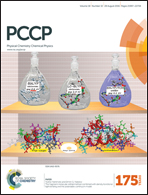In situ investigation of energy transfer in hybrid organic/colloidal quantum dot light-emitting diodes via magneto-electroluminescence†
Abstract
Energy transfer (ET) and charge injection (CI) in the hybrid organic/colloidal quantum dot light-emitting diodes (QD-LEDs) have been investigated by using magneto-electroluminescence (MEL) as an in situ tool. The feasibility and availability of MEL as an in situ tool were systematically demonstrated in the typical QD-LEDs based on CdSe–ZnS core–shell QDs. Our results suggest that the ET and CI processes can be well discerned by MEL measurements since these two processes exhibit distinct responses to the applied magnetic field. Through measurement of the MEL and current efficiency, we indicated that ET would be the main mechanism for light emission in the present hybrid QD-LEDs. This study strongly suggests that MEL could be a highly sensitive fingerprint for ET, which provides a facile and efficient method for the in situ investigation of fundamental processes in hybrid organic/colloidal QD-LEDs and other organic/inorganic composites.


 Please wait while we load your content...
Please wait while we load your content...